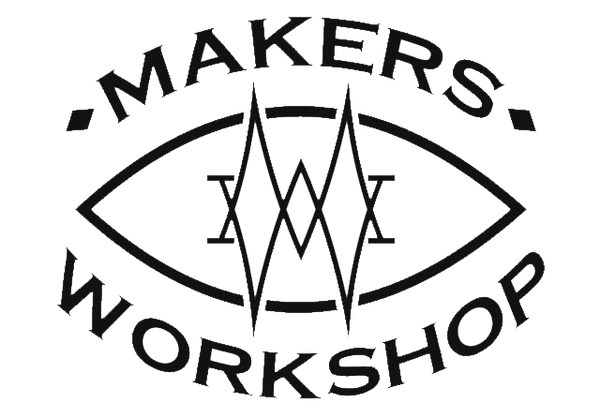Once I had the largest of the two hole saws locked into place on my drill, I set up two pieces of scrap wood to drill on top of, and clamped my first piece on top so it was secure. I did this so I wouldn’t drill into the table. From there I drilled a wide range of circles in the same size from pieces of my scrap wood. I wanted a mix of wood types and thicknesses to add visual interest.
I’ve found that the key to getting good results with a hole saw is applying moderate pressure and keeping a steady hand. The hole saw can heat up when used on thicker pieces, so be ready. The slower you go, the less scorching you can expect.
Once I had a good mix of round disks, I made different arrangements of them until I was happy with it. All of the scrap wood circles should have a hole directly in the center from the hole saw which will line up perfectly when they are stacked.
To prep for the glue, I lined my pieces up in the order I wanted them. I painted the top of the bottom piece with a liberal coat of wood glue. Then, using a drill bit as a guide for the holes on the circles, I stacked the next piece on top. I repeated this process until I had the whole stack assembled. I used TitebondIII Woodglue because it was what I had on hand but most wood glues would work well for this. I pushed the drill bit all the way in to keep it aligned while I clamped the block. Once I had it clamped down, I removed the drill bit and cleaned it off so it didn’t glue itself in place.
This dried overnight. I used two parallel bar clamps and plywood to clamp the piece down to my table. I also added a piece of plywood as a bumper to create resistance when I drill in with the smaller hole saw.
This would be easier on a drill press, but I will try and be as level as possible as I’m going in with my drill. Also, the hole down the middle of this will help guide the hole saw as I go. The main reason that I chose to go with the drill to show a method that doesn’t require big expensive tools.
On the first side, I went as far as I could until I bottomed out the hole saw. Then I flipped my piece. In theory, as long as I lined up with that hole I drilled on the other side, I could expect it to work perfectly.
And it did!
The core ended up big enough to make a second pencil cup, so I repeated the process on that one with another smaller hole saw.
To sand these down, I used my spindle sander. I only sanded down the interiors at this point, starting at an 80 grit sandpaper to sand the bulk of the imperfections off quickly. Later I topped it off with a 220 grit to smooth things off and give a nice finish sand.
Using a wood glue and CA glue combination, I glued a disc to the base of each shell. The wood glue dries slowly for a strong bond, and the CA glue dries immediately when it comes into contact with activator and serves as a clamp.
I switched out the attachment on my spindle sander and sanded down the outer edge. I took my time, and sanded the cup vertically and horizontally. I made sure to keep spinning it around so I would get an even sand. I smoothed things out with a 220 grit at the end.
At this point I removed the excess dust with paint thinner and I let both cups dry completely. Then it was time for the finish! I finished these with 3 coats of satin wipe-on poly which gave it a nice high end look in my opinion.
This ended up being a really effective method to make a container without using a lathe.
